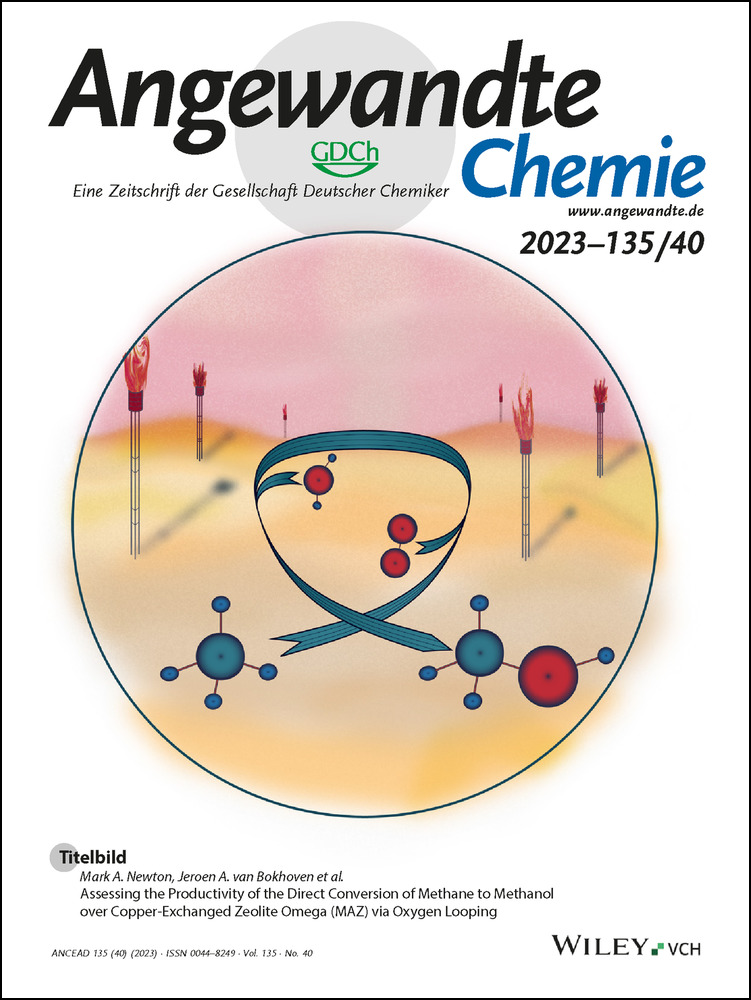Toward Magneto-Optical Cryogenic Thermometers with High Sensitivity: A Magnetic Circular Dichroism Based Thermometric Approach
Abstract
Remote temperature probing at the cryogenic range is of utmost importance for the advancement of future quantum technologies. Despite the notable achievements in luminescent thermometers, accurately measuring temperatures below 10 K remains a challenging endeavor. In this study, we propose a novel magneto-optical thermometric approach based on the magnetic-circular dichroism (MCD) technique, which offers unprecedented capabilities for meticulous temperature variation analysis at cryogenic temperatures. The inherent temperature sensitivity of the MCD C-term, in conjunction with both positive and negative signals, enables highly sensitive magneto-optical temperature probing. Additionally, a groundbreaking relative thermal sensitivity value of 95.3 % K−1 at 2.54 K can be achieved using a mononuclear lanthanide complex, [[Ho(acac)3(phen)], in the presence of a 0.25 T applied magnetic field and using a combination of multiparametric thermal read-out with multiple regression. These results unequivocally demonstrate the viability and effectiveness of our methodology for cryogenic temperature sensing.
Temperature is a vital parameter that requires close monitoring across various fields.1-3 Its criticality extends to numerous processes, including biological procedures, chemical reactions, and the successful implementation of a wide range of technologies. The significance of monitoring temperature becomes increasingly crucial in cutting-edge technologies such as superconductors, spintronics, quantum information processing, and quantum magneto-optical memories. In these domains, temperature assumes a critical role in information retention, particularly at ultra-low temperatures below 10 K.4-6 This importance is exceptionally accentuated in the current era where quantum computers are becoming a reality, facilitated by the use of dilution refrigerators that can achieve temperatures approaching absolute zero. Therefore, accurate temperature monitoring is critical to maintain the property of a material (e.g., quantum state, superconducting state), optimize performance, and prevent any deviation that may lead to the loss of its highly sought-after property.4-6
In recent years, luminescence thermometry has been successfully demonstrated as a highly sensitive remote technique to probe temperature.1-3 Several concepts have been employed to target different probing strategies, such as band-shift,7-9 lifetime,10-12 energy-transfer-based ratiometric thermometry,13-25 and single-band,26-38 each approach having its own advantages/disadvantages. In the presented context, bifunctional compounds acting as Single-Molecule Magnet (SMM) and Stark-sublevel ratiometric luminescent thermometers have been demonstrated as potential candidates for magnetic memory storage devices with real-time temperature sensing.26-38
Nevertheless, despite the demonstrated success of different approaches, implementing luminescence thermometry at very low temperatures (<10 K) remains a difficult task. Most temperature-dependent processes that favor temperature-related spectral changes, such as energy-transfer (ET), hot bands population, and quenching pathways, are inefficient at such low temperatures.20-38 Another potential limitation in luminescence thermometry with molecular complexes is the choice of ligands with adequate energy-level position to promote an effective ET to the metal center and act as an efficient luminescent material. Therefore, not all complexes can be used as luminescent thermometers, and even in the context of high-performing SMMs, systems containing large and strongly luminescent counterions and/or radical-based systems are not suitable for luminescence thermometry.
To overcome these issues and open new avenues for temperature probing at low temperatures, we introduce a new concept based on magnetic circular dichroism (MCD) magneto-optical thermometry. MCD spectroscopy is a technique that relies on the differential absorption (ΔA) of left and right circularly polarized light (lcp and rcp, respectively) components induced by a magnetic field oriented parallel (positive H) or antiparallel (negative H) to the direction of the light propagation.39-55 The ΔA signal results from the Zeeman effect (magnetic perturbation) of the states involved in the optical transitions (Scheme 1).
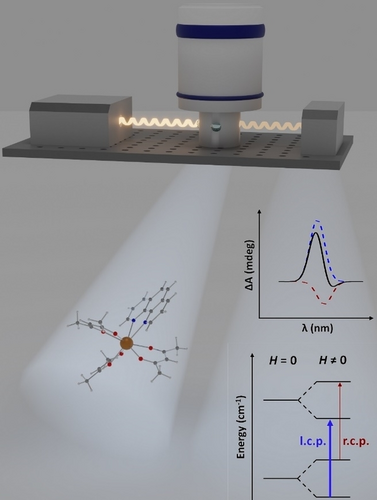
Schematic representation of the experimental setup. The sample, [Ln(acac)3(phen)], is located inside of the magneto-optical cryostat (crystalline structure of the complexes represented in the scheme). The light from the spectrometer reaches the sample and is detected by the detectors. The lcp and rcp (left and right circularly polarized light) components were detected and the differential absorption signal generated via the expression ΔA=lcp–rcp.
As an absorption-based technique, the lanthanide sharp bands are expected to be observed; also, due to the stronger spin-orbit coupling, another advantage is that f-f transitions will be much stronger than ligand bands, allowing the temperature probing with molecular compounds where luminescent processes are not observed. Additionally, dual signalled bands (i.e., positive and negative signals) permit the implementation of simple thermometric strategies based on the band difference, which does not require extensive post-treatment of the data for obtaining the temperature. Although it is not the focus of this work to describe theoretical aspects of the MCD spectroscopy in-depth, a concise discussion is presented in the ESI. For a more comprehensive exploration of the theoretical aspects, interested readers are encouraged to refer to the listed reference.39-41
To target the first demonstration of the potential of MCD-based magneto-optical thermometers, we opt for simplicity in terms of synthetic procedures. Herein we studied three isostructural mononuclear complexes, [Ln(acac)3(phen)], where Ln stands for NdIII, DyIII, and HoIII (Scheme 1, Figures S2–S4). Solid-state MCD spectra were obtained at 1.55 K under various applied magnetic fields (0.25 T to 7 T; Figure 1). Characteristic bands due to f-f absorptions are noticed for all three compounds. These MCD bands arise from the specific ground states (NdIII: 4I9/2; DyIII: 6H15/2; HoIII: 5I8) to different excited f states. Also, mirror-image is observed when applying a magnetic field antiparallel to the light direction (negative H). Aiming to understand each compound contribution, we selected the most intense bands for the MCD analysis (Figure S5–S7 and Table S1). Investigation of the field dependence of the selected MCD bands reveals that each band presents a unique profile (Figure S8). These differences are related to distinct polarizations of different electronic transitions.56-58 For NdIII and DyIII complexes (Figure S8), some bands exhibit complete saturation at distinct fields. In contrast, other transitions display a decrease in the signal after reaching saturation. It should be noted that this decrease occurs for highly mixed transitions in which the combination of levels and sublevels in close proximity can result in crossing on the Zeeman sublevels at high fields (see Figure S9 for a hypothetical example). As a result, the differential absorption (ΔA) of lcp and rcp components are perturbated, changing the direction of ΔA. For the HoIII complex (Figure S8), the selected transitions do not reach saturation.
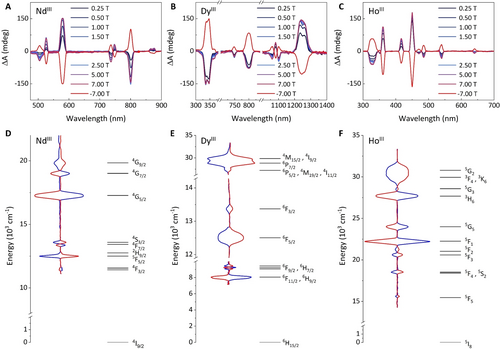
(A–C) MCD spectra obtained at 1.55 K under different applied magnetic field for (A) NdIII, (B) DyIII, and (C) HoIII complexes. (D–F) Partial energy level diagram (D) NdIII, (E) DyIII, and (F) HoIII complexes. The spectra depicted in the center is the +7 (blue line) and −7 T (red line) spectra from (A–C) converted to wavenumber units.
As discussed in the theoretical aspects section (see ESI), the temperature-dependent C-term dominates the MCD spectra of lanthanide compounds. The temperature effect on the C-term for an lcp-dominated transition band is shown in Scheme 2. Increasing the temperature increases the upper Zeeman sublevel population, resulting in a global decrease of the MCD signal. Consequently, lcp and rcp-dominated transitions will behave similarly but decrease in opposite directions. Thus, by taking advantage of the difference between a lcp and a rcp dominated transition band, we can implement a highly sensitive thermometric parameter (Δ) for probing the temperature. It should be noted that by taking the transition band difference, we are implementing a simple yet elegant thermometric parameter that does not require extensive post-treatment of the data or complicated functions for Δ determination. Based on this temperature effect on the MCD C-term, we analyzed the variable-temperature (VT) MCD spectra for the synthesized complexes with an applied magnetic field of 0.25 T.

Temperature effect on MCD transitions. Increasing the temperature results in a higher population of the upper Zeeman sublevel by a factor of kT. In this example we can see the reduction of the lcp and enhancement of the rcp components, resulting in a global decrease of the MCD band intensity. In this scheme the enhancement of the rcp component and consequently, the band asymmetry is exaggerated in order to facilitate the understanding of the effect.
 (1)
(1)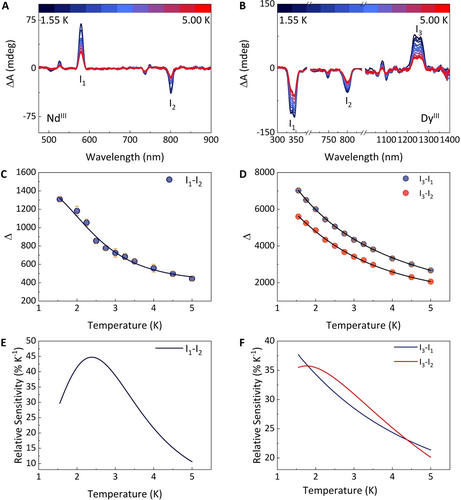
Variable-temperature MCD spectra for NdIII and DyIII complexes under a 0.25 T applied magnetic field. VT MCD spectra for (a) NdIII and (b) DyIII complexes. Temperature dependence of the Δ parameter for (c) NdIII and (d) DyIII complexes. Relative sensitivities calculated for (e) NdIII and (f) DyIII complexes.
 (2)
(2)The first term is the function's derivative, and the second term is the fitted Δ values. The maximum Sr values (Sm) obtained and the temperature of the maximum Sr value (Tm) for NdIII and DyIII complexes, respectively, are summarized in Tables S2 and S3. For the NdIII complex, an unprecedented Sm value of 44.7 % K−1 was observed at 2.38 K under a 0.25 T applied magnetic field, a value much higher than observed for any other optical thermometer operating at cryogenic ranges, thus representing the most sensitive thermometric implementation observed at cryogenic temperatures. The small energy gap between the Zeeman sublevels explains this high sensitivity value. Although slightly less sensitive, the DyIII complex also presents remarkable values for Sm, with values of 37.7 (at 1.55 K) and 35.7 % K−1 (at 1.76 K), depending on the band pair chosen for probing the temperature.
The present results indicate that MCD-based magneto-optical thermometers have considerable potential to be implemented as cryogenic thermometers. The few examples of lanthanide optical thermometers operating at cryogenic temperatures rely on lanthanide-lanthanide energy transfer (for example, TbIII-EuIII) or Stark-sublevel (MJ) population distribution approaches.20-38 Although both methods are successfully demonstrated, there is only a small margin of improvement for the sensitivity values. For the lanthanide-lanthanide energy-transfer system, several reports demonstrate how the sensitivity is tuned via metal distances and composition, suggesting that there is no margin to enhance the sensitivities at this temperature range substantially. For MJ-based luminescent thermometers, the relatively significant energetic difference between the lower and upper sublevels (tens to hundreds of wavenumbers) limits the sensitivities values yet has as an advantage the increase of the operational range. MCD-based magneto-optical thermometry, on the other hand, has the benefit of dealing with much smaller energy differences (see theoretical aspects section in the ESI) due to the small energy gap between Zeeman sublevels, facilitating the thermal population of the upper levels and consequently boosting up the sensitivities values.
Besides the outstanding results obtained with the NdIII and DyIII complexes, we also studied the magneto-optical thermometric performance of the HoIII complex (Figure 3). For this complex, the presence of several bands with considerable intensities (three positive and three negative) possibilities the implementation of nine different thermometric parameters (Figure 3b) thus revealing another advantage of MCD based magneto-optical thermometers. The possibility of implementing other thermometric parameters in various spectral regions highlights this approach versatility. For the HoIII complex, Sm values as high as 42.3 % K−1 at 2.50 K can be obtained under a 0.25 T applied magnetic field (Table S4).

Variable-temperature MCD spectra for HoIII complex under a 0.25 T applied magnetic field. (a) VT MCD spectra for HoIII complex. (b) Temperature dependence of the different Δ parameters. (c) Relative sensitivities calculated for the different Δ parameters.
For all the previous results, we used an applied magnetic field of 0.25 T. Based on the theoretical aspects of MCD spectroscopy; it is easy to predict that increasing the magnetic field strength decreases the temperature sensitivity. Increasing the magnetic field results in the broader opening of the Zeeman sublevel gaps, enhancing the required energy to populate the upper Zeeman sublevel (Figure S10). Therefore, the sensitivities decrease, but the operational ranges are enhanced. To demonstrate how the performance is affected by different magnitude magnetic fields, we obtained the VT-MCD spectra for all three complexes under 0.5, 1.0, 1.5, and 5.0 T applied magnetic fields (Figure S11–S22, Tables S2–S4). It is evident from the presented data that the operational range is significantly stretched towards higher temperatures with the cost of a dramatic reduction of Sr.
 (3)
(3) (4)
(4)As can be observed in Figures 4a and c, the combination of the nine thermometric approaches in the HoIII complex via a multiple regression enhances the maximum Sr when applying a 0.25 T magnetic field to an unprecedently value of 95.3 % K−1, and reduces δT to approximately 0.008 K. Additionally, open up the possibility of magneto-optical thermal sensing with higher magnetic fields, increasing the maximum Sr under a 5.00 T magnetic field to 3.6 % K−1 and reducing δT to approximately 0.6 K, a remarkable performance enhancement when compared with the single parameter thermal sensing.
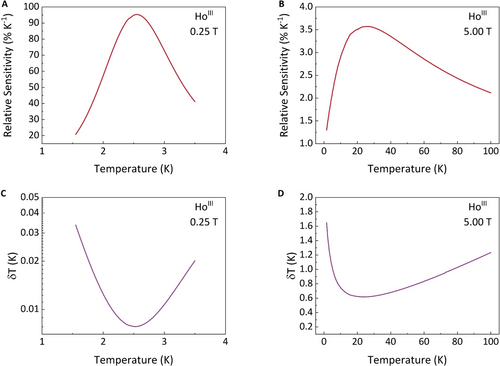
Relative sensitivities calculated for the HoIII complex obtained via the combination of multiparametric thermal sensing and multiple regression under an applied magnetic field of (a) 0.25 T and (b) 5.00 T. Associated temperature uncertainties obtained under an applied magnetic field of (a) 0.25 T and (b) 5.00 T.
In summary, herein, we demonstrate the implementation of magneto-optical thermometers via MCD spectroscopy for the first time. Despite being the first example, the obtained thermal relative sensitivities are among the highest ever observed for a lanthanide optical thermometer, suggesting that this technique possesses tremendous potential for magneto-optical temperature probing. For example, the NdIII complex can reach a maximum relative sensitivity of 44.7 % K−1 at 2.38 K under an applied magnetic field of 0.25 T, an unprecedented value at the cryogenic temperature range. The high sensitivities arise from the nature of the MCD technique. The temperature-dependent C-term, in conjunction with positive and negative signals decreasing in different directions, results in an elegant and extremally sensitive approach to probe the temperature. Additionally, for complexes containing several transition bands, as for the HoIII complex, it is possible to enhance the magneto-optical thermal sensing via a combination of multiparametric thermal read-out and multiple regression, positively impacting the accuracy of the temperature read-out. Applying this methodology yielded an unprecedently maximum relative sensitivity of 95.3 % K−1 at 2.54 K under an applied magnetic field of 0.25 T.
We foresee that MCD-based thermometry will enormously impact the field of bifunctional SMMs, opening the possibility to implement remote real-time probing of temperature for high-performance SMMs in which the luminescence is not operant. Such achievement can have an immense impact when aiming for multifunctional cryogenic materials for fields such as spintronics, quantum information processing, and magneto-optical memories.
Acknowledgments
This work was supported by the Canadian Foundation for Innovation, and the Natural Sciences and Engineering Research Council of Canada.
Conflict of interest
The authors declare no conflict of interest.
Open Research
Data Availability Statement
The data that support the findings of this study are available in the supplementary material of this article.



